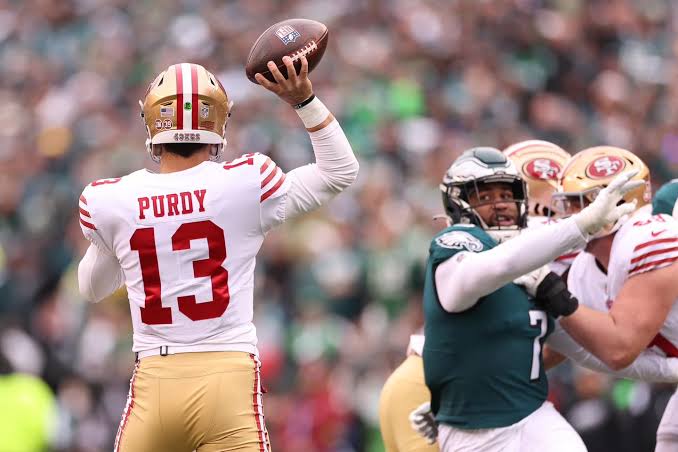
Adam Peters explains what the 49ers liked about Brock Purdy during the NFL Draft process
In NFL discussions, it’s intriguing to see how individuals reminisce about past drafts, particularly when examining the San Francisco 49ers. For those inclined towards optimism, they often highlight the team’s successes, such as uncovering All-Pro talents from seemingly less prominent draft rounds, like the third and fifth rounds.
In the realm of NFL assessments, scrutiny often falls on recent underperforming draft selections like Trey Sermon and Tyrion Davis-Price, highlighting the 49ers’ occasional swings and misses. However, it’s indisputable that the 49ers approach each draft with a meticulously crafted plan, though its success remains up for debate. Trey Lance’s draft position has garnered considerable criticism, largely due to the hefty draft capital San Francisco invested in him.
Despite his limited playing time, Lance has already been labeled by some as a disappointment. The 49ers recognized the pressing need for a quarterback with greater potential than their existing roster offered and found an unconventional solution in Trey Lance. Former 49ers assistant general manager Adam Peters recently addressed the team’s strategy at the NFL Combine, where he discussed the pursuit of quarterbacks like Brock Purdy.
“Brock…he’s always composed. Like he is now, he’s the same guy every day. Really, his tape is what really turned us on. I mean, you meet the person, but this is only a little bit about the process. His tape and, everything that he did at Iowa State and how well he plays and how well he played the position, we really thought that he could fit in really well with our scheme.
If we thought he was that good we probably wouldn’t have waited until the last pick. But, uh, we liked him that much. Now, I gotta find a new quarterback.”
In the NFL, the ability to identify a player’s strengths and project how those attributes will integrate into a team’s specific scheme is paramount in talent evaluation. This strategic foresight is a hallmark of the 49ers’ management under the leadership of Kyle Shanahan and John Lynch. Their adeptness at pinpointing player strengths and envisioning how those qualities will mesh with the team’s offensive and defensive systems has been a key factor in their success. This astute approach to player evaluation has enabled the 49ers to consistently assemble rosters that complement their preferred style of play, contributing to their competitiveness on the field.
Purdy’s performance appears consistent with his time at Iowa State, maintaining a similar skill set despite transitioning to the NFL. Dre Greenlaw continues to exhibit the same level of intensity and athleticism demonstrated during his tenure at Arkansas. Ji’Ayir Brown’s knack for locating the football, a trait showcased at Penn State, remains a defining aspect of his play.
While talent evaluation plays a significant role, luck and fortuitous circumstances also influence player opportunities. The probability of Purdy receiving playing time without injuries to Lance or Jimmy Garoppolo was exceedingly low. Similarly, Brown’s ability to showcase his abilities this season was contingent on favorable circumstances, albeit to a lesser extent.
Related
Archives
Categories
- 2024 Australian Open
- 49
- 49ERS
- 49ers vs Lions
- 49ers vs. Chiefs
- 69ERS
- AFL
- AFLW
- American Football
- anonymous
- Arsenal
- Aston Villa
- AUSX 2024
- AUSX OPEN
- Baltimore Ravens
- Baseball
- Basketball
- Billionaires
- blog
- Books
- Boston Celtics
- Boxing
- Brisbane Bronco
- Buffalo Bills
- Canadian Football league
- Car Racing
- Caroline Panthers
- Celtics
- Championship
- Chelsea
- Chess
- Crystal Palace
- Cycling
- Dallas Cowboys
- Dallas Mavericks
- Dirt bike
- Djokovic
- Dodgers
- Dortmund
- Essendon Bombers
- Florida gators
- Football
- Fremantle Dockers
- Fullham
- general
- German Masters
- Giants pride
- Golden State Warriors
- Golf
- Hockey
- Houston Texans
- Indiana Fever
- Indiana Pacers
- Ipswich
- Ipswich Town
- Kansas city chiefs
- KYLE LARSON
- Lakers
- Larry bird
- LIFE STYLE
- LIFESTYLE
- Liverpool
- Los Angeles Dodgers
- Los Angeles Rams
- Mallas Cowboys
- Manchester city
- Manchester United
- Michealan Wolverines
- Michigan wolverine
- Michigan Wolverines
- Milwaukee brewers
- MLB
- MLB Aaron judge
- Motocross
- MotoGP
- Motorcross
- Music
- MXGP
- NASCAR
- NBA
- New England Patriots
- New Orleans pelicans
- Newcastle United
- NFC Championship
- NFL
- NFL Trade
- NHL
- Nottingham Forest
- Oil and Gas
- Olympic
- other
- Other Sports
- OU Softball
- PGA
- Philadelphia Eagles
- Philadelphia Flyers
- Philadelphia Phillies
- Pittsburgh Steelers
- Playoffs
- Racing
- Ravens smith
- Real Madrid
- Rugby
- San Francisco Fiants
- San Francisco Giants
- SEAL Team
- sevila
- Snooker
- Snooker Masters
- Sports
- St. Louis Cardinals
- Super Bowl LVIII
- Superbowl
- Supercross
- Ted Lasso
- Tennis
- TONY STEWART
- Toronto Raptors
- Tottenham Hotspur
- Tour de France
- Transfer News
- Uncategorized
- Video Games
- West ham
- Winnipeg Blue Bombers
- Wrexham
- WWE
Leave a Reply